Crafting AI Prompts: 5 Expert Tips for Contact Centers
Ever since COVID, contact centers have increasingly invested in Artificial Intelligence (AI). In fact, according to a recent MarketsandMarkets report, the global contact center AI market is expected to grow at a CAGR of 21.3% from $1.6 billion (May 2022) to $4 billion by 2027. AI technologies like chatbots, virtual assistants, speech recognition, Interactive Voice Response (IVR), Natural Language Processing (NLP), predictive analytics, and sentiment analysis are quickly becoming integral to contact centers' operations.
AI-powered contact center solutions offer a way to improve efficiency and customer satisfaction, but only if the AI is properly used. In this article, we will share with you five expert tips on crafting AI prompts for maximum outcome, ensuring that your AI-powered contact center solution is a valuable asset to your business.
To Write Your Own Prompts, Or Not To Write Your Own Prompts
Whenever you are deciding between different AI-driven products, it is very important to understand how much flexibility you will have in fine-tuning its prompts. There are solutions on the market that allow you to craft your own prompts with complete freedom, while other solutions will come with predefined prompts that you cannot customize. Of course, each approach has its pros and cons. You will need to consider trade-offs that involve flexibility, ease of use, and the potential for customization to specific needs.
Predefined prompts are often perceived as offering simplicity and a quicker start, especially for teams without the resources to experiment and refine custom interactions. However, they may not cater to the nuanced needs of every business, potentially limiting the scope of insights and the effectiveness of AI-driven solutions.
In MiaRec, we decided to give our customers full flexibility over the prompts they can craft because it offers significant advantages in terms of adaptability to customer needs. Tailoring prompts to your organization's unique requirements can lead to more accurate call scoring, more insightful summaries, and effective agent coaching that directly addresses the areas most critical to your operations.
While the thought of creating prompts might seem daunting at first, keep in mind that you are using natural language to interact with the AI, just as you do with ChatGPT or Microsoft Copilot. By adhering to a few basic principles, we will explain below, you can write clear instructions that will return consistent, on-target results.
1. Play With The AI's Capabilities To Understand Its Capabilities And Limitations
To truly understand the limits and possibilities AI can bring to your contact center, you need to run your own experiments with it. Although it might be fun to ask ChatGPT to write cute poems or a travel itinerary, it isn't enough to judge how useful AI will be in your contact center. You need to actively experiment with the AI's capabilities to discover innovative ways to leverage its functionalities for your specific needs.
Treat this exploration as an opportunity to engage in a dynamic dialogue with the AI, pushing the boundaries of its abilities and challenging it to perform tasks that may initially seem beyond its scope. Through this process, you will gain a deeper understanding of the AI's limitations and strengths, enabling you to optimize its deployment and maximize its impact on your contact center operations.
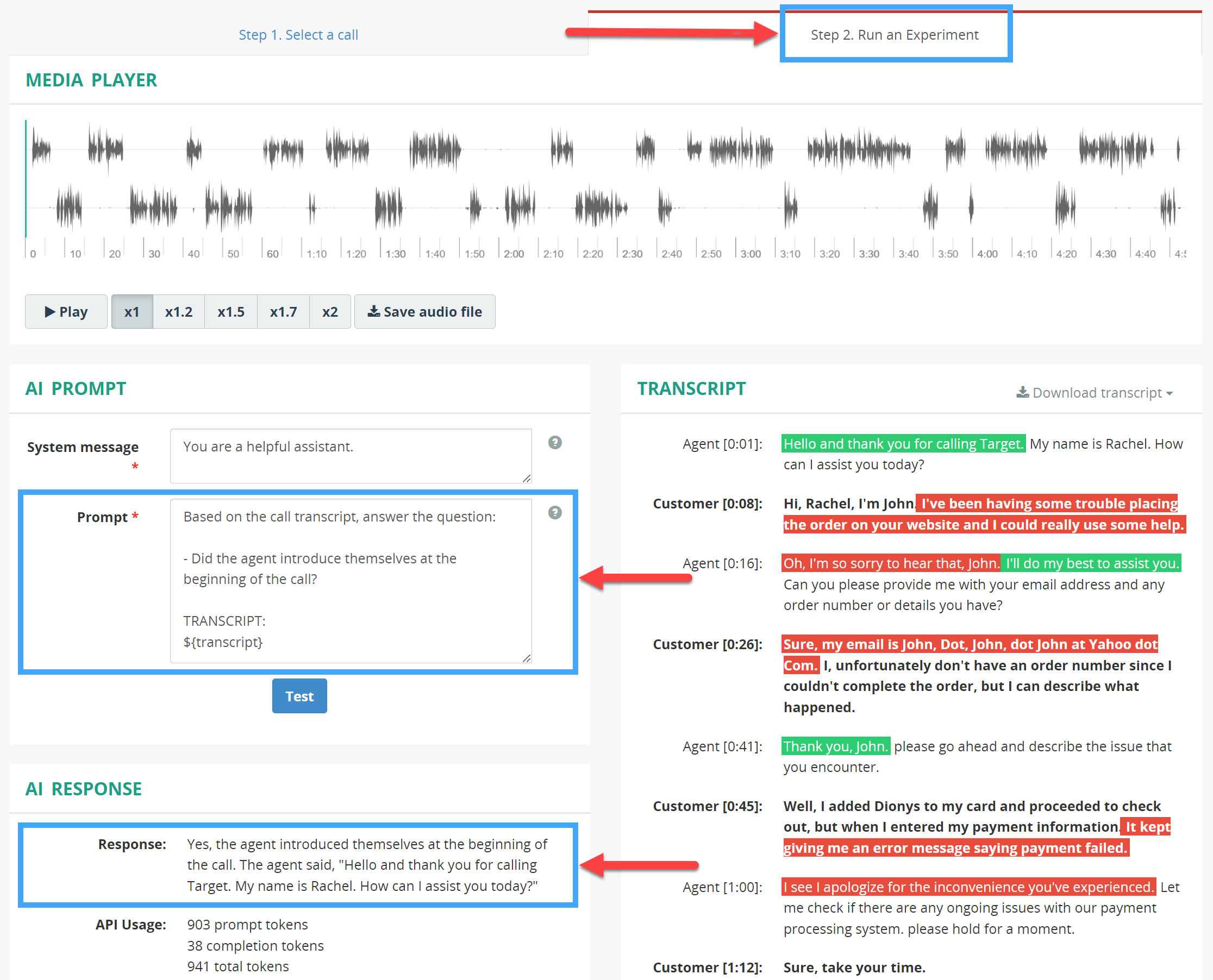
Screenshot: This screenshot of the MiaRec AI Prompt Designer testing environment shows how to run an experiment or test out a prompt on an actual call.
To get the most out of this, we highly recommend you experiment on actual calls. MiaRec is now offering an AI Prompt Designer that allows you to experiment with crafting prompts, create AI-driven scorecards, and much more on your real-world customer interaction — but without the risk of impacting anything. Essentially, it is a safe sandbox, and you can try everything out first before deploying it in the real world. By doing so, you can:
- Analyze the AI's response accuracy: Compare the AI's responses to the actual information present in the call transcript. Assess how well the AI extracts the desired information or performs the intended task.
- Refine prompts for optimal performance: Based on the analysis of the AI's responses, refine your prompts to improve their accuracy and efficiency. This may involve adjusting the instructions, providing additional context, or modifying the response format. For example, instead of asking AI the question "Did the agent greet the caller appropriately?" explain to AI what "appropriate" means for you. Ask "Did the agent greet the caller appropriately by saying "Thank you for calling", "How can I assist you today" or similar?"
- Enhance response quality: Test and refine prompts to ensure that the AI's responses are clear, concise, and easy to understand. Strive for responses that provide the necessary information in a user-friendly manner, i.e. easy to consume by reviewers. For example, you can restrict AI to answer from a list of pre-defined options (like "Sold", "Not sold", "N/A") rather than giving a lengthy response.
- Identify insufficiency of the input data: Understand the limitations of the input data. AI needs the right context to provide an accurate response. Ask only the questions that can be answered based on solely a call transcript. For example, it would be impossible for AI to answer the question, "Did the agent document the case properly in the CRM system?" because a call transcript doesn't have sufficient evidence for that. Also, in most solutions, AI sees only an individual call, it doesn't know anything about the previous interactions of the customer with the contact center.
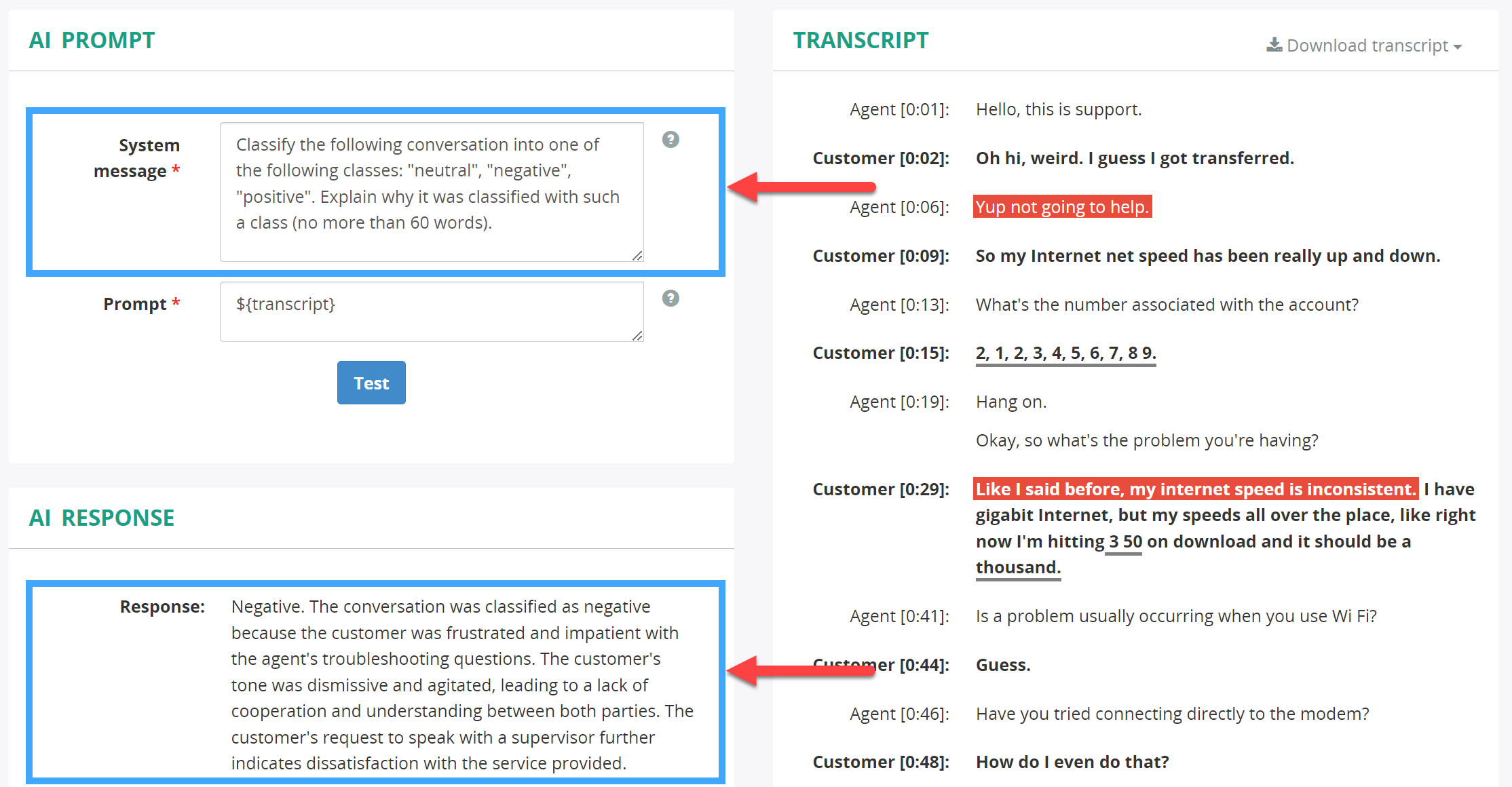
Screenshot: Example of AI Prompt for Sentiment scoring.
Regular testing and refining your prompts with actual call data is essential for maintaining their effectiveness. By continuously monitoring and improving your prompts, you can ensure that your AI system delivers accurate and evidence-based responses, ultimately enhancing the overall quality of the AI insights.
2. Be Specific, Clear, And Unambiguous
Generative AI is really good at understanding the entire context of your customer conversations. It can automatically summarize the call, assign a call reason, extract key facts, evaluate the agent's performance, provide coaching suggestions, and much more. But to harness its full capabilities, it requires precise and unambiguous instructions.
This means you need to be as clear and specific as you can, avoiding vague or open-ended questions. By being as specific as possible, you can ensure that the AI system understands exactly what is expected of it. To illustrate the impact of specificity, let's consider two prompts for an automated call scoring to evaluate agent performance:
- Weak prompt: "Did the agent introduce themselves properly?"
- Better prompt: "Did the agent state their first and last name at the beginning of the call?"
The second prompt is much more specific because it clearly outlines the expected behavior (did the agent say their first and last name — Yes or No?), leaving no room for interpretation. This precision enhances the accuracy of the AI's assessment and ensures that evaluations align with the desired standards.
Another example is where the AI is tasked with categorizing customer calls based on their reasons for calling. You can either simply ask the AI to categorize by defining the categories at will, or you can give it examples to choose from:
- Weak prompt: "Provide the reason for the call."
- Better prompt: "Provide the reason for the call, using one of the following categories: Place an order, Cancel an order, Problem with the order, Check product pricing, ..."
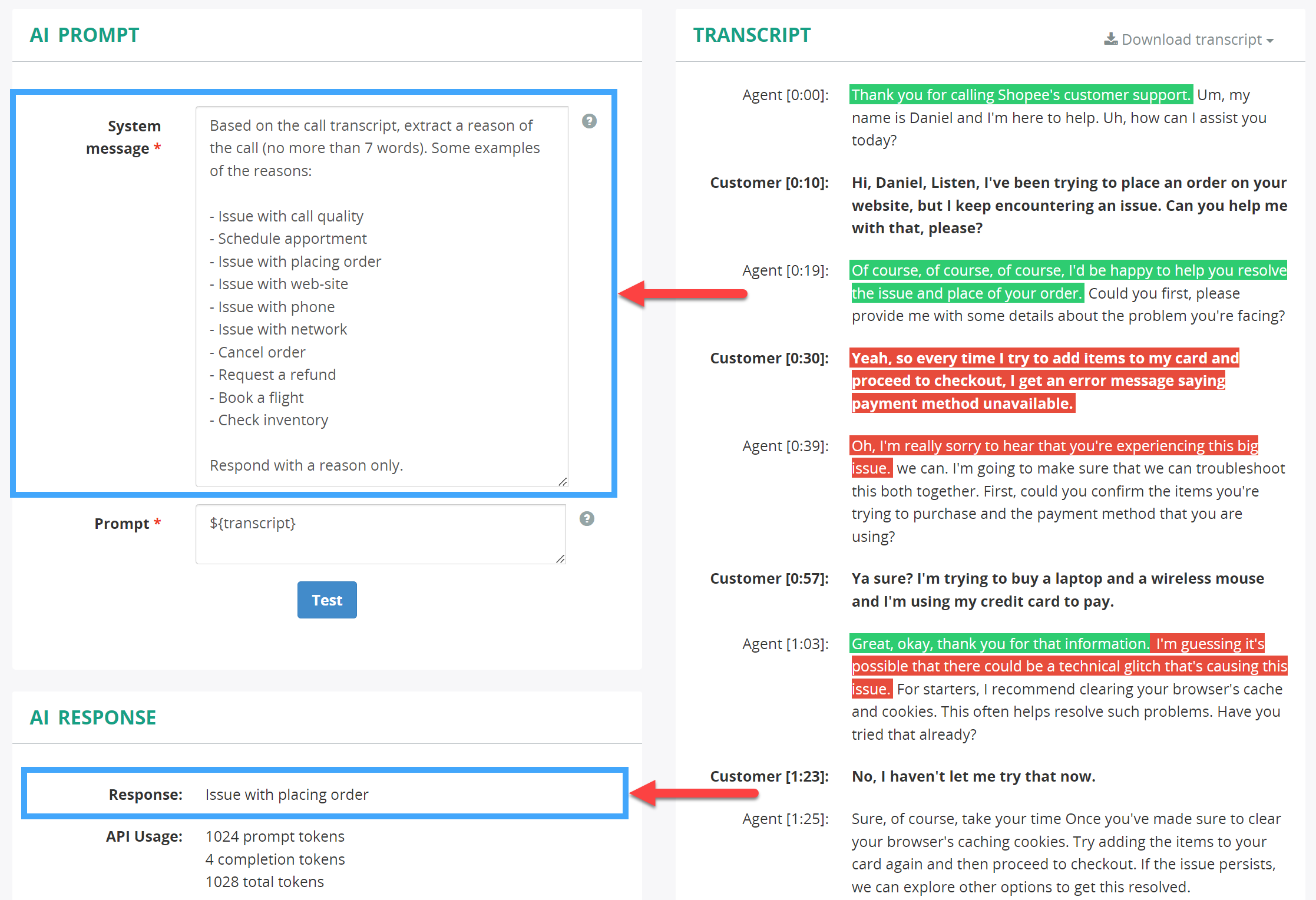
Screenshot: Example of a prompt for categorizing calls.
Providing a predefined list of acceptable answers that the AI can choose from ensures consistent and reliable results. This level of specificity becomes particularly crucial when using the extracted information for reporting purposes.
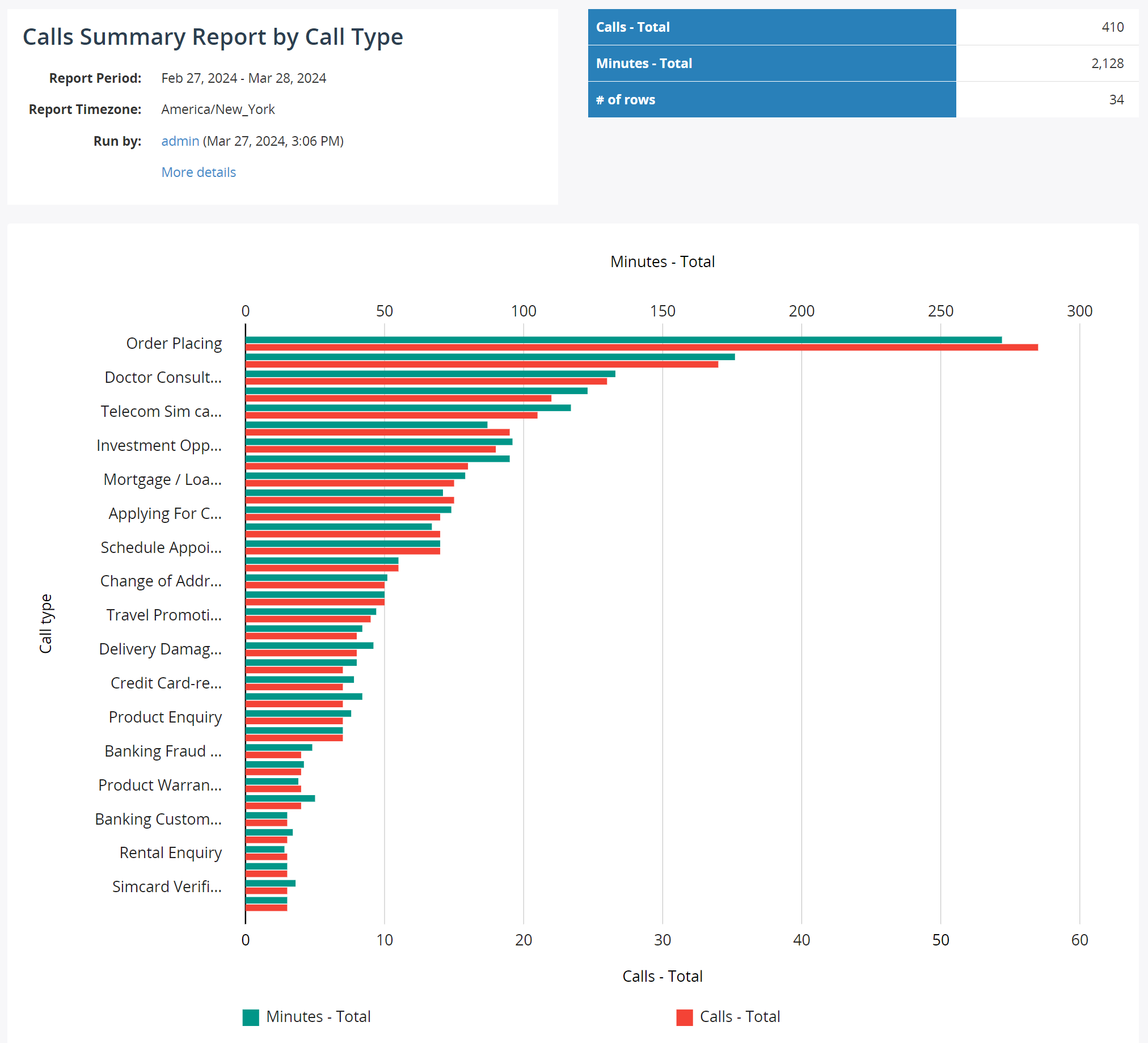
Screenshot: A Call Summary Report by Call Type in MiaRec.
3. Know What You Can (And Cannot) Ask AI To Do
AI is great at a LOT of different use cases in a contact center. But there are some things that it cannot do or cannot do well. Below are some scenarios where Generative AI evaluating agent performance in the contact center won't be able to score accurately, which might lead the AI to hallucinate (make up an answer based on the most likely outcome):
- Did the agent enter the call information correctly into the company's CRM system? The AI cannot know if the information was entered correctly and how well because it isn't privy to that kind of information.
- How well did the agent empathize with customers? This is particularly true in complex emotional scenarios. While Generative AI can gauge a lot from the context, it might not be very accurate all the time.
- Did the agent effectively handle calls that significantly deviated from typical scripts or expected topics? Script adherence and repetitive processes are amazing use cases for Generative AI, but if your support staff needs to deviate on a lot of calls, you might need to create specific scorecards or have more human oversight.
- How did the agent's tone and manner contribute to the overall customer experience? Analyzing and predicting subjective outcomes beyond the content of what is said is hard for AI.
- How accurately did the agent follow and apply nuanced company policies or procedures that require interpretation and judgment? While Generative AI will become more sophisticated over time and be aware of company policies and knowledge bases to evaluate this better, most auto call-scoring solutions rely on the context of the customer interaction. If the answer isn't findable in the transcript, the AI won't be able to answer it correctly.

Screenshot: Example of a weak AI Prompt that leaves room for interpretation.
4. Tell AI What Format You Want Your Response In
When crafting AI prompts for your contact center, it's crucial to specify how you want the AI to format its responses. By requesting specific response formats, such as bulleted lists or numbered items, you can make the information easier for your users to understand and process. This clarity enhances the overall efficiency and accuracy of your contact center operations.
Specifying response formats is essential for several reasons. First, it ensures consistency in the way information is presented. When users receive data in a standardized format, they can quickly scan and locate the relevant information they need, reducing the time spent searching through unstructured text.
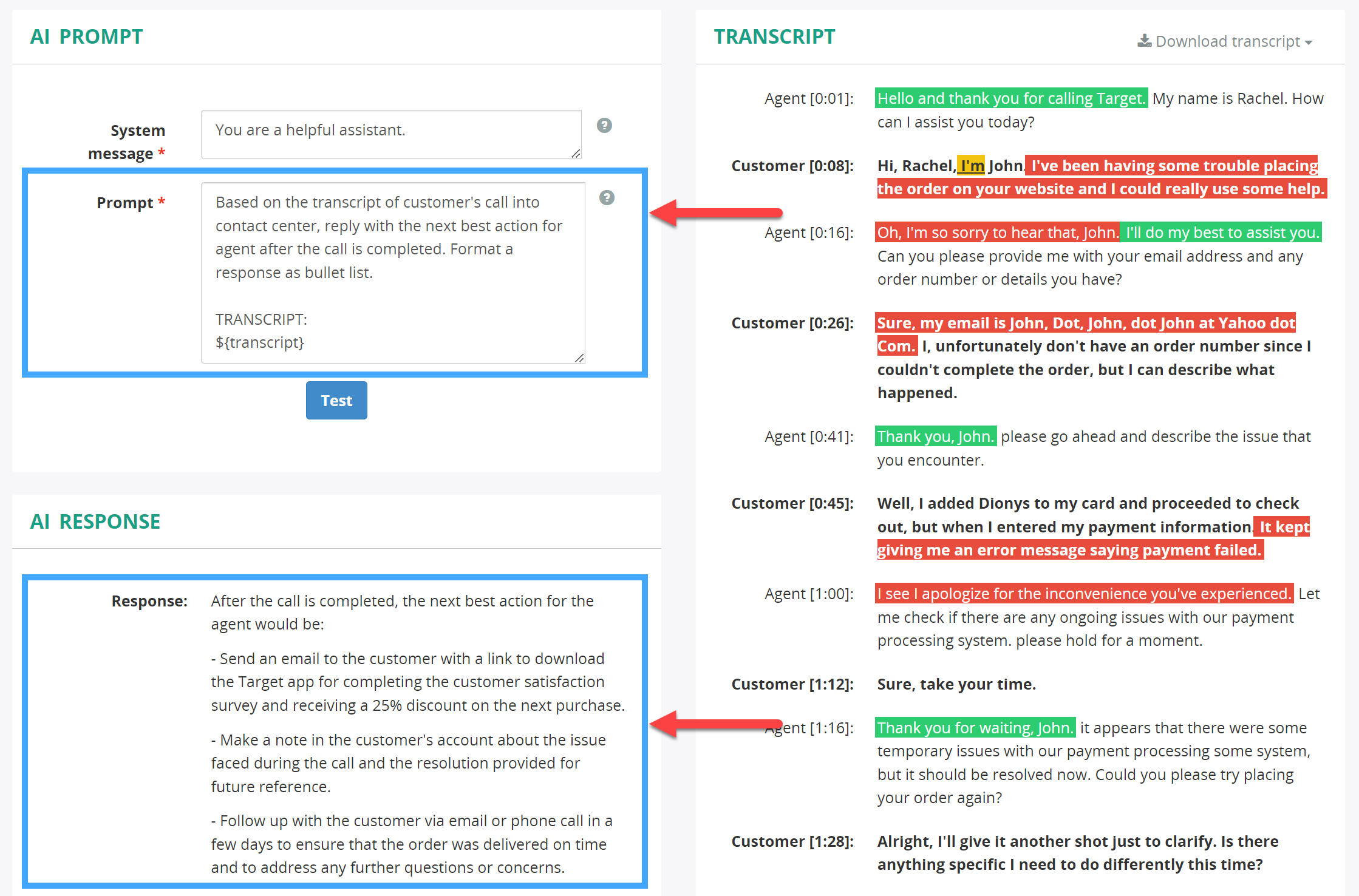
Screenshot: Example of the AI Prompt with a request to provide a response in bullet list format.
Second, with standardized responses from AI, organizations can use the extracted data insights to build aggregated reports, allowing them to have a bird's-eye view of contact center operations.
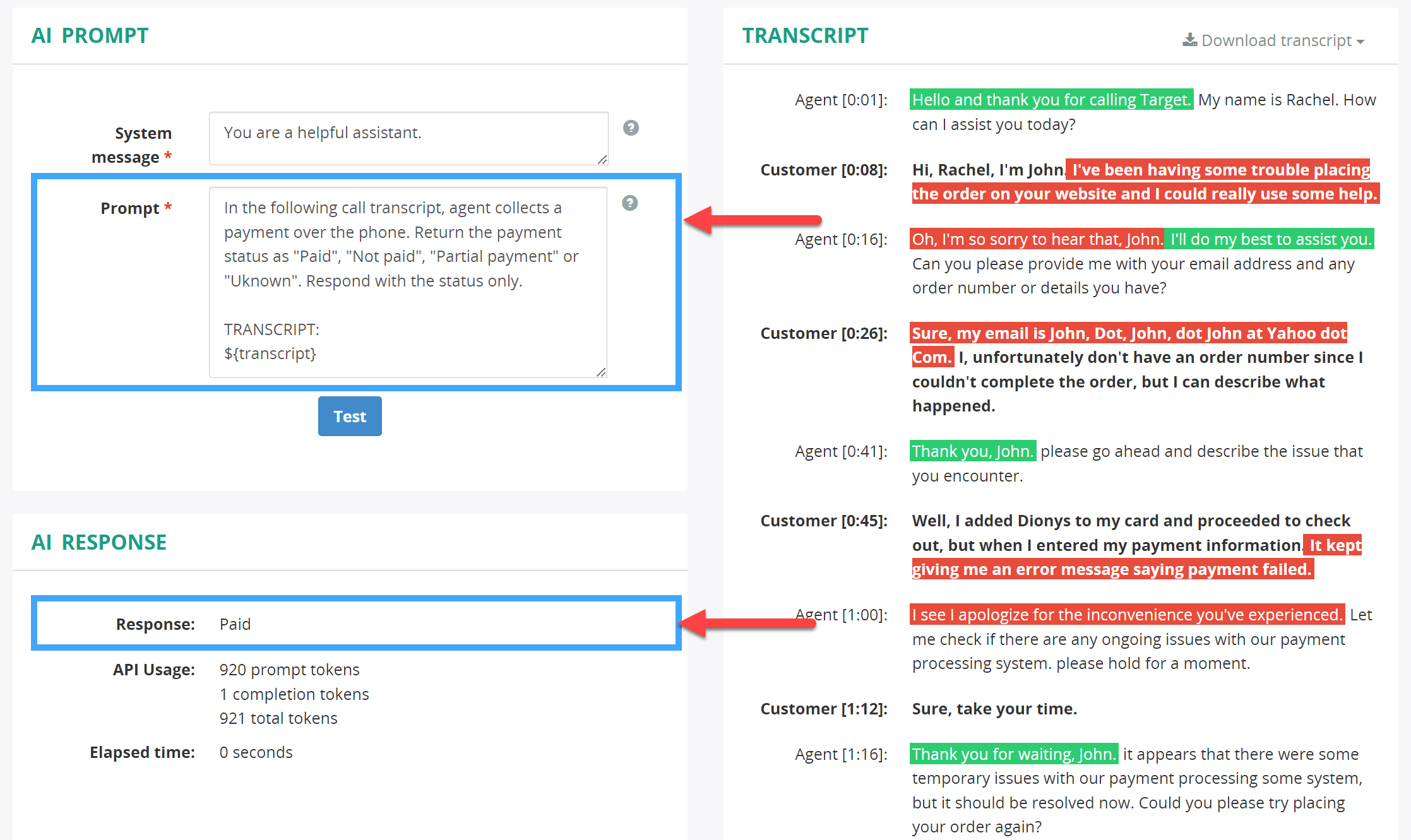
Screenshot: Example of the AI Prompt with instructions of the expected response format, suitable for reporting.
To effectively request specific response formats, consider the following tips:
- Provide examples or templates: To further assist the AI in understanding your formatting preferences, include examples or templates of the expected response format. This visual aid helps the AI grasp the desired output and reduces the chances of misinterpretation.
- Consider the context and purpose of the response: Tailor the response format based on the context and purpose of the AI's response. For instance, if the response involves a list of steps or instructions, a numbered list might be more appropriate, while a bulleted list might be better suited for presenting a set of options or features.
- Test and refine: As with any AI implementation, testing and refining are crucial to achieving optimal results. Experiment with different response formats and assess their effectiveness based on end users' feedback. Continuously monitor and adjust the response formats to ensure they align with your evolving needs and goals.
By requesting specific response formats, you empower your contact center AI to deliver information in a structured and easily digestible manner. This enhances the efficiency of end users who analyze the AI-generated data insights, whether they are supervisors evaluating agent performance or managers reviewing the aggregated reports.
5. Adjust The Length Of The Responses
In certain scenarios, you may need the AI to provide more comprehensive and in-depth responses. To achieve this, you can ask the AI to provide a detailed response or limit the length of a response by instructing the AI to generate no more than a certain number of words.
Test different limits and analyze their impact on response quality and efficiency. If not restricted, the AI can generate lengthy responses that take time for end users to read and analyze. Find the right balance between the length of the response and the number of details included.
When using AI to summarize calls, limit the response length to 50-100 words. Instead of asking AI to create a generic call summary, ask it to focus on the key areas that are important for you (like the customer's name, date of insurance claim incident, date of incident, etc.). The summary must be as short as possible yet informative.

Screenshot: Example of the AI Prompt with instructions of the expected response format.
Conclusion
The investment in learning to craft effective prompts pays off by providing a solution that grows with your company, offering deep insights tailored to your unique challenges and opportunities.
Remember, testing and refining your prompts is an iterative process. Continuously evaluate the AI's responses, analyze feedback, and make necessary adjustments. By leveraging MiaRec's AI Playground, you can accelerate this process, rapidly honing your prompts to achieve maximum accuracy and efficiency.
Share this
You May Also Like
These Related Stories

MiaRec (Literally) On Our Soapbox About AI

Auto Call Summary: 3 Ways to Streamline Insurance Contact Centers




